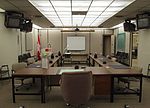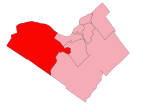West Carleton Secondary School
1989 establishments in OntarioEducational institutions established in 1989High schools in Ottawa
West Carleton Secondary School is a secondary school situated in the rural west end of Ottawa, Ontario, Canada. The school is under the jurisdiction of the Ottawa Carleton District School Board.
Excerpt from the Wikipedia article West Carleton Secondary School (License: CC BY-SA 3.0, Authors).West Carleton Secondary School
Dunrobin Road, Ottawa
Geographical coordinates (GPS) Address Phone number External links Nearby Places Show on map
Geographical coordinates (GPS)
| Latitude | Longitude |
|---|---|
| N 45.4344 ° | E -76.0349 ° |
Address
West Carleton Secondary School
Dunrobin Road 3088
K0A 1T0 Ottawa (West Carleton-March)
Ontario, Canada
Open on Google Maps





